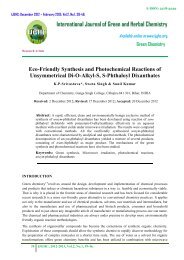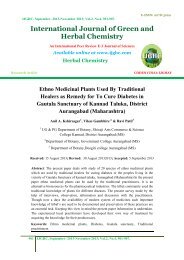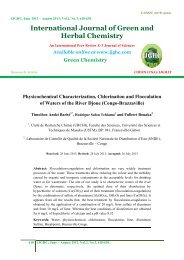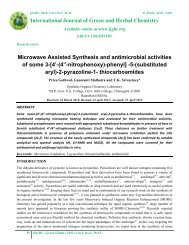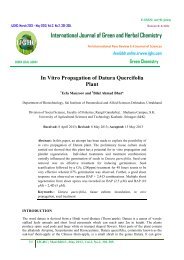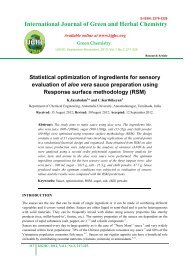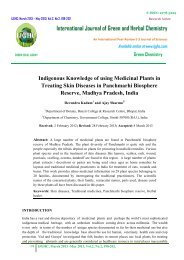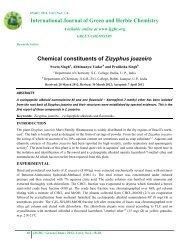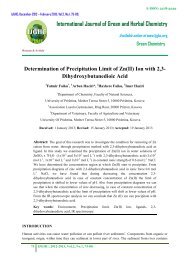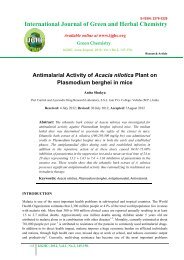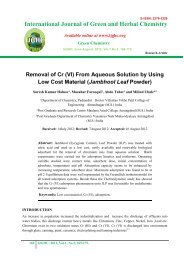International Journal of Green and Herbal Chemistry - IJGHC
International Journal of Green and Herbal Chemistry - IJGHC
International Journal of Green and Herbal Chemistry - IJGHC
You also want an ePaper? Increase the reach of your titles
YUMPU automatically turns print PDFs into web optimized ePapers that Google loves.
E-ISSN: 2278-3229<br />
E-ISSN: 2278-3229<br />
<strong>IJGHC</strong>; March 2013 – May 2013; Vol.2, No.2, 271-274.<br />
Research Article<br />
<strong>International</strong> <strong>Journal</strong> <strong>of</strong> <strong>Green</strong> <strong>and</strong> <strong>Herbal</strong> <strong>Chemistry</strong><br />
An <strong>International</strong> Peer Review E-3 <strong>Journal</strong> <strong>of</strong> Sciences<br />
Available online at www.ijghc.com<br />
CODEN (USA): IJGHAY<br />
<strong>Herbal</strong> <strong>Chemistry</strong><br />
Estimation <strong>of</strong> the Type <strong>and</strong> Quantity <strong>of</strong> Sugars in Banana<br />
(Musa cumenita or Cavendish group)<br />
Anita Makwana, Ekta Gupta <strong>and</strong> Ajit V P<strong>and</strong>ya*<br />
Department <strong>of</strong> Biochemistry, C.U. Shah Science College, Ahmedabad, Gujarat, India<br />
Received: 12 April 2013; Revised: 4 May 2013; Accepted: 10 May 2013<br />
Abstract: The utilization <strong>of</strong> locally available fruits is limited due to lack <strong>of</strong><br />
information <strong>and</strong> knowledge on their nutritive values. The sugars present in the banana<br />
fruit were investigated. The green banana tasted plain because it contained large<br />
amount <strong>of</strong> starch, while the yellow banana tasted sweet since it contained large<br />
amount <strong>of</strong> reducing sugars. The result revealed that the sugars present in banana arefructose,<br />
glucose <strong>and</strong> sucrose; were found to be as 4.35 g in 20gm <strong>of</strong> quantity. The<br />
value obtained were found to be below the daily recommended intake. The analysis<br />
revealed that banana has greater amount <strong>of</strong> fructose, glucose <strong>and</strong> sucrose present in it.<br />
It is therefore recommended that banana should be consumed in our daily life. The<br />
total amount <strong>of</strong> sugars present in banana is 27.5g in a medium sized banana.<br />
Keywords: Carbohydrates, glucose, fructose, sucrose,<br />
INTRODUCTION<br />
Carbohydrates are the most abundant bio-molecules on Earth. Certain carbohydrates (sugar <strong>and</strong><br />
starch) are a dietary staple in most parts <strong>of</strong> the world, <strong>and</strong> the oxidation <strong>of</strong> carbohydrates is the central<br />
energy-yielding pathway in most non-photosynthetic cells. Insoluble carbohydrate polymers serve as<br />
structural <strong>and</strong> protective elements in the cell walls <strong>of</strong> bacteria <strong>and</strong> plants <strong>and</strong> in the connective tissues<br />
<strong>of</strong> animals. Other carbohydrate polymers lubricate skeletal joints <strong>and</strong> participate in recognition <strong>and</strong><br />
adhesion between cells. Carbohydrates are polyhydroxy aldehydes or ketones, or substances that yield<br />
such compounds on hydrolysis. Many, but not all, carbohydrates have the empirical formula<br />
(CH2O)n; some also contain nitrogen, phosphorus, or sulfur. There are three major size classes <strong>of</strong><br />
271 <strong>IJGHC</strong>; March2013 -May 2013, Vol.2, No.2, 271-274.
Estimation ….<br />
Anita Makwana et al.<br />
carbohydrates: monosaccharide, oligosaccharides, <strong>and</strong> polysaccharides (the word “saccharide” is<br />
derived from the Greek sakcharon,meaning“sugar”). Simple sugars are called monosaccharide <strong>and</strong><br />
glucose, fructose <strong>and</strong> galactose. The table sugar most customarily used as food is sucrose,a<br />
disaccharide. Other disaccharides include maltose <strong>and</strong> lactose. The average person consumes about 24<br />
kgs <strong>of</strong> sugar each year equivalent to over 260 food calories per person, per day.<br />
The banana plant is the largest herbaceous flowering plant. The plants are normally tall <strong>and</strong> fairly<br />
sturdy <strong>and</strong> are <strong>of</strong>ten mistaken for trees, but their main or upright stem is actually a pseudostem that<br />
grows 6 to 7.6 meters (20 to 24.9 ft) tall, growing from a corm. Individual banana fruits (commonly<br />
known as a banana or 'finger') average 125 grams (0.28 lb), <strong>of</strong> which approximately 75% is water <strong>and</strong><br />
25% dry matter. Generally, modern classifications <strong>of</strong> banana cultivars follow Simmonds' <strong>and</strong><br />
Shepherd's system. The accepted names for bananas are Musa acuminata, Musa balbisiana or Musa<br />
acuminata × balbisiana, depending on their genetic ancestry. Bananas were introduced to the<br />
Americas by Portuguese sailors who brought the fruits from West Africa in the 16th century. The<br />
word banana is <strong>of</strong> West African origin, from the Wol<strong>of</strong> language, <strong>and</strong> passed into English via Spanish<br />
or Portuguese.<br />
Bananas are among the most popular fruits enjoyed in the U.N. Chiquita br<strong>and</strong>s <strong>International</strong> claims<br />
that the average American eats 27 pounds <strong>of</strong> bananas each year. Bananas are cheap <strong>and</strong> available<br />
year-round ,<strong>and</strong> with their sugar content they provide a quick burst <strong>of</strong> natural energy to power you<br />
through your day.<br />
Many wild banana species as well as cultivars exist in extraordinary diversity in New Guinea,<br />
Malaysia, Indonesia, China, <strong>and</strong> the Philippines.<br />
The vast majority <strong>of</strong> the world's bananas today are cultivated for family consumption or for sale on<br />
local markets. India is the world leader in this sort <strong>of</strong> production, but many other Asian <strong>and</strong> African<br />
countries where climate <strong>and</strong> soil conditions allow cultivation also host large populations <strong>of</strong> banana<br />
growers who sell at least some <strong>of</strong> their crop. In 2009, India led the world in banana production,<br />
representing approximately 28% <strong>of</strong> the worldwide crop, mostly for domestic consumption. Flavor <strong>and</strong><br />
texture are also affected by ripening temperature. Bananas are refrigerated to between 13.5 <strong>and</strong> 15 °C<br />
(56 <strong>and</strong> 59 °F) during transport. At lower temperatures, ripening permanently stalls, <strong>and</strong> turns the<br />
bananas gray as cell walls break down. The skin <strong>of</strong> ripe bananas quickly blackens in the 4 °C (39 °F)<br />
environment <strong>of</strong> a domestic refrigerator, although the fruit inside remains unaffected. During the<br />
ripening process, bananas produce a plant hormone called ethylene, which indirectly affects the<br />
flavor. Among other things, ethylene stimulates the formation <strong>of</strong> amylase, an enzyme that breaks<br />
down starch into sugar, influencing the taste <strong>of</strong> bananas. The greener, less ripe bananas contain higher<br />
levels <strong>of</strong> starch <strong>and</strong>, consequently, have a "starchier" taste. On the other h<strong>and</strong>, yellow bananas taste<br />
sweeter due to higher sugar concentrations. Furthermore, ethylene signals the production <strong>of</strong> pectinase,<br />
an enzyme which breaks down the pectin between the cells <strong>of</strong> the banana, causing the banana to<br />
s<strong>of</strong>ten as it ripens. The banana plant has long been a source <strong>of</strong> fiber for high quality textiles.<br />
According to the USDA National Nutrient Database, a single medim banana contains about 105<br />
calories <strong>and</strong> roughly 14.43g <strong>of</strong> total sugars. Sugar is a carbohydrate, supplying 4 calories per gram.<br />
That means close to 58 <strong>of</strong> these calories come just from the sugar content. Put another way, a medium<br />
banana is approximately 55% sugar. Fortunately, bananas contain natural sugars <strong>and</strong> supply a good<br />
deal <strong>of</strong> vitamins <strong>and</strong> nutrients that make it a healthy choice for most people.<br />
The sugar content <strong>of</strong> bananas changes as they ripen,in a process controlled by a plant hormone known<br />
as ethylene. <strong>Green</strong> bananas are almost all starch <strong>and</strong> have low sugar content. As the bananas ripen,the<br />
starch content decreases, then sucrose appears. Next,fructose <strong>and</strong> glucose appear <strong>and</strong> increase. After<br />
272 <strong>IJGHC</strong>; March2013 -May 2013, Vol.2, No.2, 271-274.
Estimation ….<br />
Anita Makwana et al.<br />
about 28 days <strong>of</strong> ripening, sucrose begins to decline. The sugar content in overripe bananas can be<br />
dramatically higher than in bananas that are underripe <strong>and</strong> optimally ripe.<br />
MATERIALS AND METHODS<br />
Sample collection: The banana fruit <strong>of</strong> middle size was purchased directly from the Shahibaug<br />
Market in the beginning <strong>of</strong> month September , 2012. Fresh sample <strong>of</strong> banana fruit was taken. Then it<br />
was analyzed first for the estimation <strong>of</strong> sugars. All the reagents <strong>and</strong> st<strong>and</strong>ard used in this work were <strong>of</strong><br />
laboratory grade. The methods used in this work are the st<strong>and</strong>ard methods.<br />
ESTIMATION OF SUGARS<br />
Sample analysis: The banana was peeled <strong>of</strong>f . 20.10g <strong>of</strong> the sample was taken in the h<strong>and</strong> mixer. It<br />
was then fully mashed with the help <strong>of</strong> mixer to get the banana juice <strong>and</strong> then 100 +75ml distilled<br />
water was added in it. The dilution was prepared <strong>and</strong> then it was filtered from the cotton or a muslin<br />
cloth <strong>and</strong> the quantity was made 100ml. The 50ml solution was taken for qualitative estimation <strong>and</strong><br />
rest 50ml was preserved in the refrigerator by covering the upper portion <strong>of</strong> test tube with the help <strong>of</strong><br />
aluminium foil. The qualitative estimation was performed then using st<strong>and</strong>ard methods <strong>of</strong><br />
carbohydrate estimation procedure.<br />
Tests Observation Inference<br />
Molish’s test Blue-violet colour obtained Carbohydrate present<br />
Iodine test Dark blue colour obtained Starch present<br />
Benedict’s test Orange-red colour obtained Reducing sugar (glu,fruc,mal,lac,suc)<br />
present<br />
Seliwan<strong>of</strong>f’s test Cherry red colour obtained Reducing sugars present<br />
Phosphoric acid test Brown ring obtained Reducing sugars present<br />
Barfoed test Red residue obtained Monosaccharide present<br />
Cobaltous chloride<br />
test<br />
Phenyl hydrazine test<br />
Violet colour obtained<br />
Osazone crystals obtained in<br />
5minutes<br />
Fructose present<br />
Glu,fruc,mal,lac present<br />
RESULT AND OBSERVATION<br />
Fructose <strong>and</strong> glucose are the two most abundant sugars found in bananas ,<strong>and</strong> they occur in roughly<br />
equal amounts. Bananas also contain a bit <strong>of</strong> a third sugar, sucrose. A medium banana contains<br />
approximately 5.72g <strong>of</strong> fructose. Fructose is a common sugar found in many fruits <strong>and</strong> it is also<br />
present in bananas. Natural fructose, like other simple sugars, supplies our body with energy.<br />
273 <strong>IJGHC</strong>; March2013 -May 2013, Vol.2, No.2, 271-274.
Estimation ….<br />
Anita Makwana et al.<br />
The same medium serving <strong>of</strong> banana contains about 5.8g <strong>of</strong> glucose. Glucose, most commonly known<br />
as blood sugar is the most common carbohydrate. When we eat, our body breaks down our food into<br />
this simple sugar so it can use it as energy for our cells.<br />
The sugars estimated in the above experiment are glucose <strong>and</strong> fructose<br />
REFERENCES<br />
1. Centres for disease control <strong>and</strong> prevention: Fruit <strong>of</strong> the month:Banana<br />
2. University <strong>of</strong> Hawai Nutrition ATC;Bananas Need No Hype to be considered good; Joannie Dobbs <strong>and</strong><br />
Alan Titchenal;April 2010<br />
3. “Food <strong>Chemistry</strong>”; Bioactive Amines <strong>and</strong> carbohydrate changes during ripening <strong>of</strong> ‘Prata’<br />
banana(musa acuminate-M-Balbisiana); Rigna C.Adao <strong>and</strong> M.Beatriz A. Gloria; May 2005<br />
4. Elmhurst college, Virtual Chembook; Fructose <strong>and</strong> Glucose; Charles Ophard; 2003<br />
*Corresponding Author: Dr.Ajit V P<strong>and</strong>ya<br />
Department <strong>of</strong> Biochemistry, C.U. Shah Science College, Ahmedabad, Gujarat, India<br />
274 <strong>IJGHC</strong>; March2013 -May 2013, Vol.2, No.2, 271-274.



